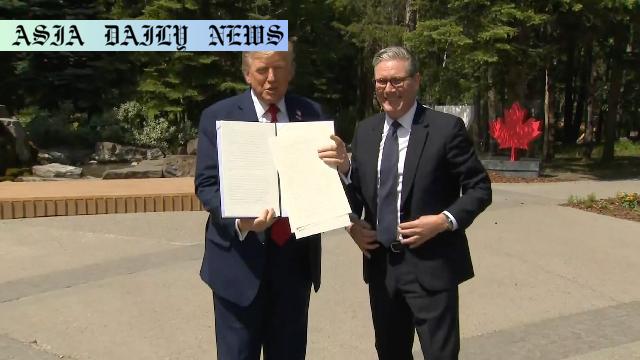Trade Deal: US President Donald Trump and UK Prime Minister Keir Starmer signed a significant trade deal at the G7 summit in Canada.
The US and UK finalized a significant trade deal at the G7 summit in Canada.
The agreement includes greater access to British markets for US exports.
A ceiling of 100,000 UK automobiles will face a 10% tariff annually.
Tariffs on UK steel and aluminum products may substantially reduce.
Further details on tariff-rate quotas are still under discussion.

Introduction: A Landmark Agreement at the G7 Summit
The Group of Seven (G7) summit in Canada witnessed a pivotal moment in international trade relations as US President Donald Trump and British Prime Minister Keir Starmer signed a groundbreaking trade agreement on Monday. This historic accord is a result of extensive bilateral negotiations in May, demonstrating a renewed commitment to strengthening economic ties between the United States and the United Kingdom.
This trade deal, touted as mutually beneficial, marks a significant step forward for both nations. It focuses on improving market access and addressing tariff barriers, setting the stage for enhanced economic cooperation. In his remarks, President Trump emphasized the potential of this agreement to create jobs and generate substantial income for both countries.
Key Provisions: Market Access and Tariff Adjustments
The agreement brings substantial benefits for businesses and consumers on both sides of the Atlantic. One of its core elements is increased access to British markets for US exports, paving the way for American companies to expand their operations and reach new customers in the UK.
For automobiles, the deal includes a quota allowing up to 100,000 UK-made cars to be exported annually to the US, subject to a 10% tariff. While this quota aligns with existing levies, it provides crucial opportunities for British automakers to maintain their market presence and compete effectively. However, certain non-tariff barriers that have historically hindered trade are expected to be eased or eliminated altogether.
Steel and Aluminum: Ongoing Discussions on Tariff Reform
A key focus of the agreement is on UK-produced steel and aluminum products. The deal proposes introducing ‘tariff-rate quotas’ or reducing tariffs significantly, fostering a more equitable trading environment. While details on these measures remain under negotiation, they represent a positive step toward resolving longstanding trade disputes.
By addressing these critical sectors, the agreement underscores the importance of reducing protectionist measures and promoting free trade. As discussions progress, stakeholders in both countries will be keenly observing how these proposed changes unfold.
A Broader Perspective: Implications for Transatlantic Trade
Beyond its immediate provisions, this trade deal holds broader implications for transatlantic trade relations. As both nations navigate the complexities of a post-Brexit and post-pandemic economic landscape, the agreement symbolizes their shared commitment to fostering growth and innovation. It also sets a precedent for future trade negotiations, potentially influencing agreements with other trading partners.
However, challenges remain in ensuring that the deal delivers on its promises. Policymakers and industry leaders must work collaboratively to address any potential hurdles and maximize the benefits of this landmark accord.
Conclusion: A Promising Start
Ultimately, the trade deal signed at the G7 summit represents a promising start toward deeper economic cooperation between the US and the UK. By focusing on mutual benefits and addressing key trade barriers, this agreement lays the foundation for a more prosperous and interconnected future.
As details continue to emerge and further discussions take place, the international community will be watching closely to see how this partnership evolves, shaping the trajectory of global trade in the years to come.



Commentary
The Significance of the US-UK Trade Deal
The newly signed US-UK trade agreement, finalized during the G7 summit, is a crucial milestone in transatlantic relations. It goes beyond mere economic provisions, symbolizing the strengthened political and diplomatic ties between two of the world’s leading economies. For the UK, in particular, this deal represents a major step in its post-Brexit journey, as it seeks to redefine its global trade partnerships outside the European Union’s umbrella.
Economic Growth and Opportunities
One of the most promising aspects of this agreement is its potential to spur economic growth. The enhancements in market access for US exporters to the UK will undoubtedly encourage innovation and competition. Similarly, British automobile manufacturers and steel producers, long burdened by tariff challenges, are likely to experience an uplift in production and market expansion due to relaxed trade barriers. The 100,000-car export limit may seem like a constraint; however, it still provides a steady gateway for UK-based industries, ensuring stability.
Challenges Ahead and Continued Negotiations
This trade deal is not without its challenges. For instance, the lack of clarity on the specifics of the tariff-rate quotas on UK steel and aluminum products reflects the complexities inherent in international trade negotiations. Further discussions will be essential to finalize these aspects, ensuring that the agreement remains equitable and beneficial for both parties in the long term. Vigilance will be required to address any emerging trade disputes or unintended consequences effectively.
Final Thoughts: Bridging Borders with Trade
In conclusion, the US-UK trade deal is not just an agreement; it is a blueprint for cooperation and shared economic prosperity. It underscores the importance of diplomacy and compromise in achieving mutually advantageous outcomes. As we look ahead, this accord serves as a reminder of the pivotal role that thoughtful negotiation plays in bridging borders and creating a more interconnected world. By focusing on commonalities rather than differences, the United States and the United Kingdom have set a positive example for global trade partnerships in the future.